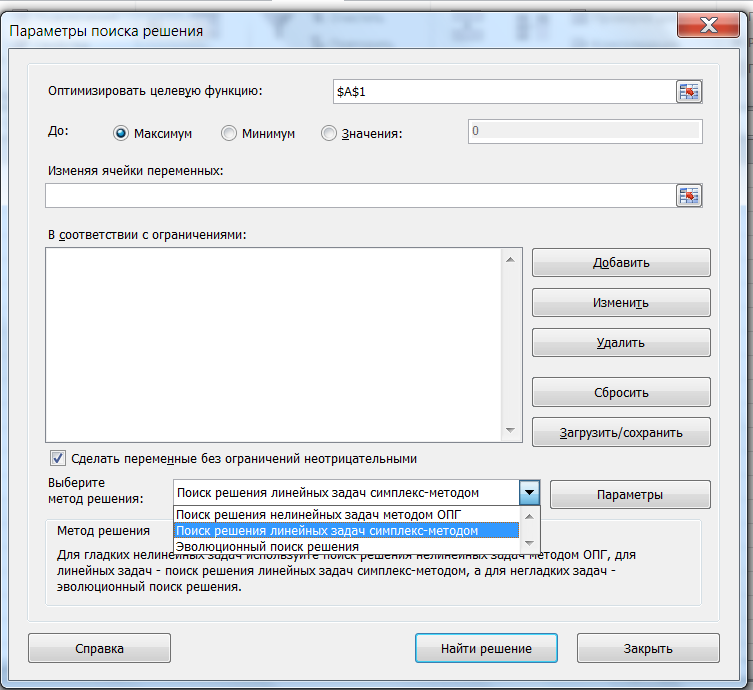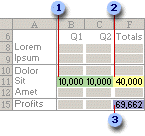
- •Окно «Параметры поиска решения в Excel 2010»
- •About Solver http://www.Solver.Com/excel2010/solverhelp.Htm
- •Solver sample worksheets
- •Define and solve a problem
- •Understanding Solver Results messages Understanding Solver Results messages
- • If you receive the message “Solver could not find a feasible solution,” read the topic Understanding the Feasibility Report. Understanding the Feasibility Report
- •Understanding the Linearity Report
- •Integer Constraints and the Integer Optimality Tolerance
- •Show Solver trial solutions
- •Pause or stop Solver
- •Problems with Poorly Scaled Models
- •Limitations on Smooth Nonlinear Optimization
- •Multistart Methods for Global Optimization
- •Problems with Poorly Scaled Models
- •Grg Nonlinear Solving Method Stopping Conditions
- •Evolutionary Solving Method Stopping Conditions
- •Evaluating a Solution Found by the Evolutionary Solving Method
- •Create Solver reports
- •Interpreting the Answer Report
- •Interpreting the Population Report
- •Interpreting the Sensitivity Report
- •Interpreting Dual Values
- •Interpreting Range Information
- •Interpreting the Limits Report
- •Understanding the Linearity Report
- •Understanding the Feasibility Report
- •Understanding the Feasibility Report
- •Algorithms and methods used by Solver
- •Nonlinear Optimization
- •Smooth Nonlinear Functions
- •Linear Programming
- •Integer Programming
- •Non-Smooth Optimization
- •Genetic and Evolutionary Algorithms
Окно «Параметры поиска решения в Excel 2010»



About Solver http://www.Solver.Com/excel2010/solverhelp.Htm
Solver is part of a suite of commands sometimes called what-if analysis tools. With Solver, you can find an optimal (maximum or minimum) value for a formula in one cell — called the objective cell — subject to constraints, or limits, on the values of other formula cells on a worksheet. Solver works with a group of cells — called decision variable cells — that participate in computing the formulas in the objective and constraint cells. Solver adjusts the values in the decision variable cells to satisfy the limits on constraint cells and produce the result you want for the objective cell.
The objective, constraint and decision variable cells and the formulas interrelating them form a Solver model; the final values found by Solver are a solution for this model. Solver uses a variety of methods, from linear programming and nonlinear optimization to genetic and evolutionary algorithms, to find solutions
Overview and Example
Use Solver to determine the maximum or minimum value of one cell by changing other cells. For example, you can change the amount of your projected advertising budget and see the effect on your projected profit amount.
Example of a Solver problem
In the following example, the level of advertising in each quarter affects the number of units sold, indirectly determining the amount of sales revenue, the associated expenses, and the profit. Solver can change the quarterly budgets for advertising (cells B11:E11), up to a total budget constraint of $40,000 (cell F11), until the value for the total profit reaches the maximum possible amount. The values in the decision variable cells are used to calculate the profit for each quarter, so the values are related to the formula in the target cell F15, =SUM(B15:E15).
________________________________________

![]() Decision
variable cells
Decision
variable cells
![]() Constraint
cell
Constraint
cell
![]() Objective
cell
Objective
cell
________________________________________
After Solver runs, the new values are as follows.
![]()
See more examples in Solver sample worksheets.
Solver sample worksheets
Microsoft Excel includes a workbook, Solvsamp.xls in the Office\Samples folder, that demonstrates the types of problems you can solve.
You can use the sample worksheets in Solvsamp.xls to help you set up your problems. To use any of the six worksheets— Product Mix, Shipping Routes, Staff Scheduling, Maximizing Income, Portfolio of Securities, and Engineering Design— open the workbook, switch to the worksheet you want to use, and then click Solver in the Analysis group on the Data tab. The objective cell, constraint cells, and decision variable cells for each Solver model are already specified:
|
Worksheet |
Objective |
Constraints |
Decision Variables |
|
Quick Tour |
Profit (Max) |
Advertising budget |
Ad spending by quarter |
|
Product Mix |
Profit (Max) |
Parts inventory on hand |
Number of products to build |
|
Shipping Routes |
Shipping Cost (Min) |
Supplies at plants, demands at warehouses |
Number of products to ship on each route |
|
Staff Scheduling |
Payroll Cost (Min) |
Employees needed each day of the week |
Number of employees on each of 7 weekly schedules |
|
Maximizing Income |
Interest Earned (Max) |
Cash balance at end of each month |
Amount to invest in 1-, 3- and 6-month CDs |
|
Portfolio of Securities |
Portfolio Return (Max) |
Portfolio total and risk (variance) |
Percentage to invest in each of 4 stocks plus T-bills |
|
Engineering Design |
Charge (Value Of) |
None |
Resistor value in circuit |
Comments on each worksheet explain more about each Solver model. To find an optimal solution, click Solve.
